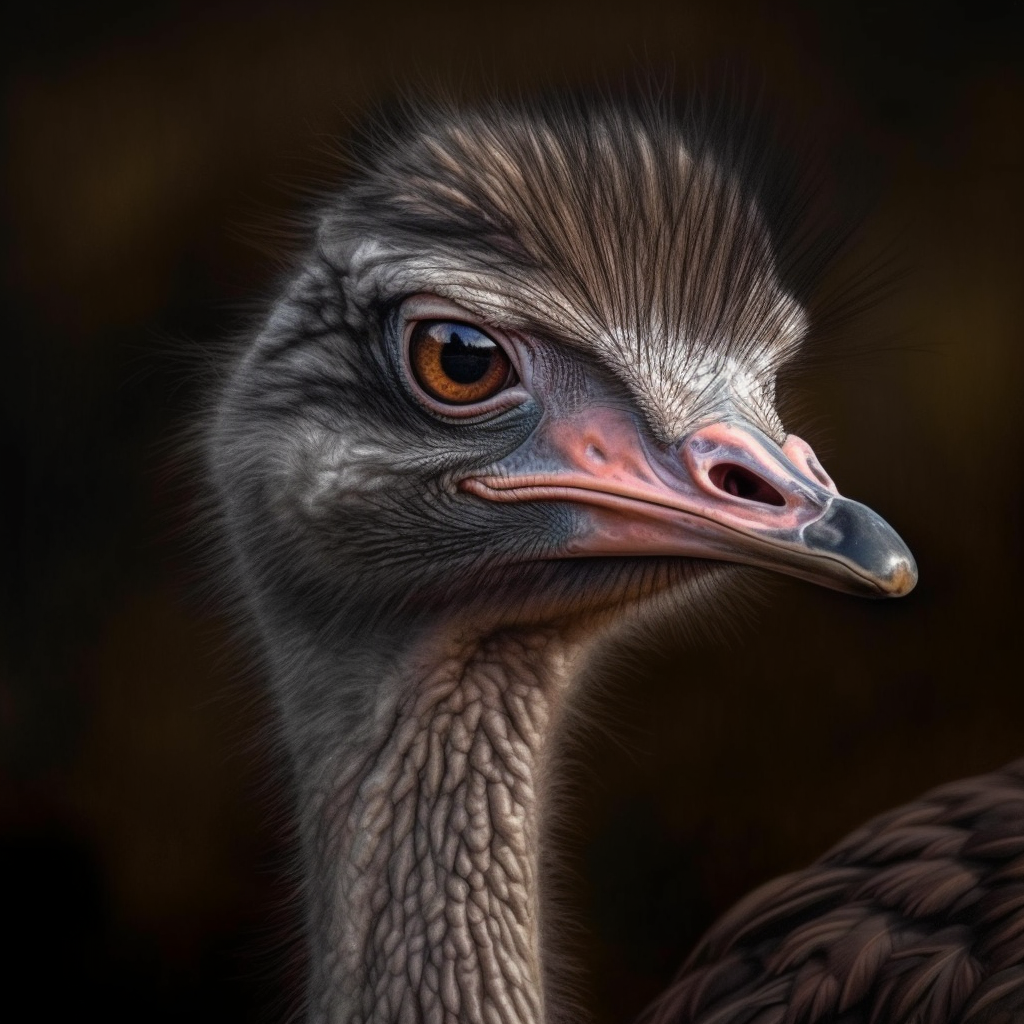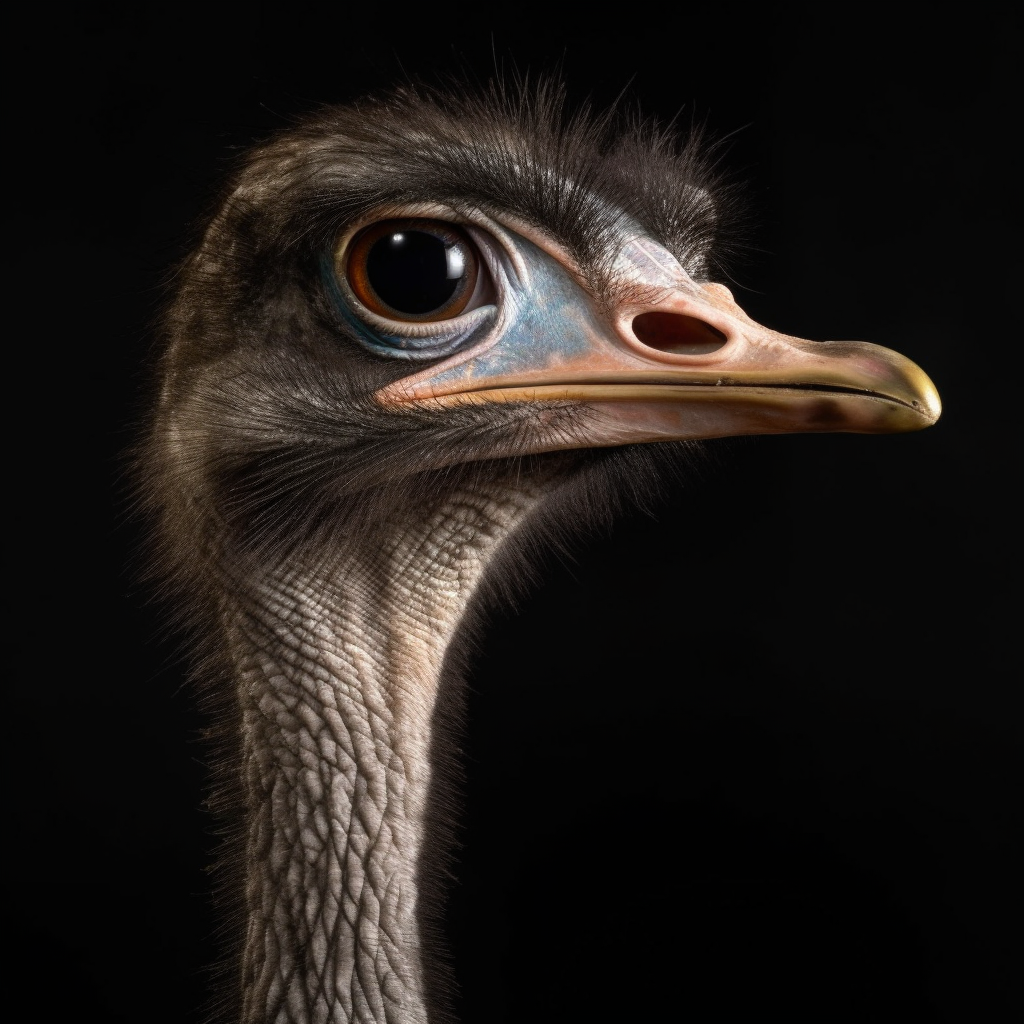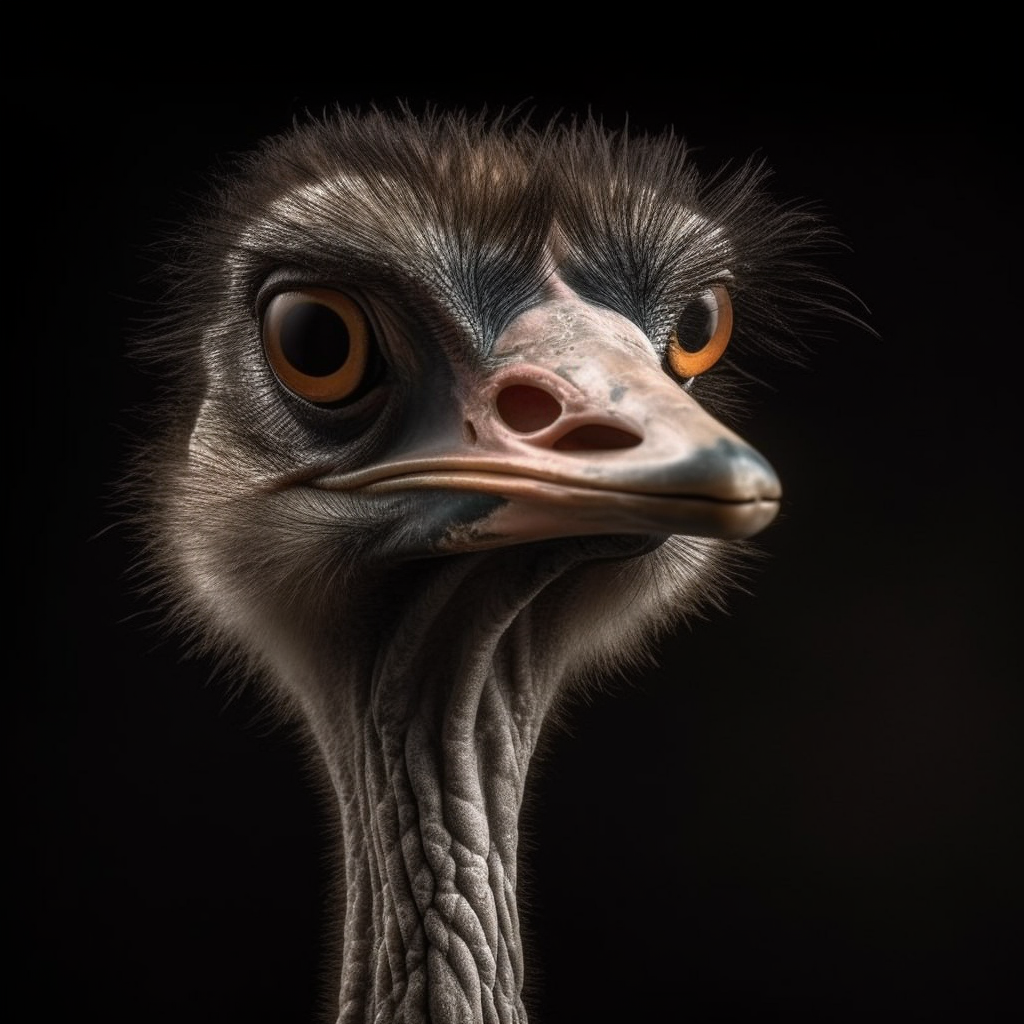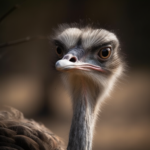Ostriches are fascinating creatures known for their impressive size and speed. With their long legs and powerful strides, they can reach speeds of up to 60 miles per hour, making them the fastest running birds on land. However, when it comes to flying, ostriches are unable to take to the skies. Despite their large wings, which span about 6 to 9 feet, these wings are not designed for flight. In this article, we will explore the reasons why ostriches cannot fly and delve into the unique adaptations that allow them to thrive on the ground. So, let’s dive in and uncover the truth about the flightless ostriches.
Key Takeaways
- Ostriches are flightless birds and cannot fly due to their large size and heavy bodies.
- Their wings are not designed for flight but are used for balance and steering while running.
- Ostriches are the largest and fastest-running birds, capable of reaching speeds up to 60 miles per hour.
- Despite being flightless, ostriches have adapted to their environment and are well-suited for survival on the ground.
The Ostrich: An Overview

A. Understanding the Ostrich: A Brief Introduction
The ostrich is a fascinating bird that captivates the imagination with its unique characteristics and behaviors. As the largest bird species in the world, the ostrich is an icon of the African savannah and a symbol of strength and resilience.
Ostriches belong to the family Struthionidae, which includes flightless birds. While most birds are known for their ability to fly, the ostrich has evolved differently. Instead of relying on flight, ostriches have adapted to their environment in other remarkable ways.
B. The Ostrich’s Unique Characteristics
One of the most striking features of the ostrich is its size. Standing at an impressive height of up to 9 feet (2.7 meters) and weighing around 220-350 pounds (100-160 kilograms), these birds are truly a sight to behold. Their long legs and necks, along with their large bodies, make them stand out among other bird species.
Ostriches have also developed unique adaptations to their flightless lifestyle. While they may not be able to fly, they have evolved powerful legs that allow them to run at incredible speeds. In fact, ostriches are the fastest land birds, capable of reaching speeds of up to 43 miles per hour (70 kilometers per hour). This incredible speed enables them to escape from predators and cover long distances in search of food and water.
Another notable characteristic of ostriches is their distinctive feather structure. Unlike most birds, ostrich feathers lack the interlocking structure necessary for flight. Instead, their feathers are loose and fluffy, providing insulation and helping regulate their body temperature in the extreme African heat. These feathers are also used for display during courtship rituals, where males flaunt their plumage to attract females.
In addition to their physical attributes, ostriches have unique behaviors. They are highly social birds, living in small groups called flocks. These flocks are often led by a dominant male, who guards the group and ensures their safety. Ostriches also have a fascinating reproductive strategy, with males building a shallow nest in the ground and females laying their eggs in it. The dominant male and other females in the group take turns incubating the eggs, showing a cooperative breeding behavior.
In conclusion, while ostriches may not possess the ability to fly, they have evolved a range of remarkable characteristics and adaptations that make them well-suited to their environment. From their impressive size and speed to their unique feather structure and social behaviors, ostriches are truly a marvel of nature.
Debunking the Myth: Can Ostriches Fly?
A. The Anatomy of an Ostrich: Why Flight is Impossible
When we think of birds, one of the first things that come to mind is their ability to fly gracefully through the sky. However, not all birds possess this remarkable skill. One such example is the ostrich, the largest bird species on Earth. Ostriches are known for their impressive size, speed, and unique adaptations, but flying is not one of them.
To understand why ostriches cannot fly, we need to take a closer look at their anatomy. Unlike most birds, ostriches have long, strong legs that are perfectly suited for running. In fact, they are the fastest land birds, capable of reaching speeds up to 60 miles per hour! Their powerful legs allow them to cover great distances in a short amount of time, making flight unnecessary for their survival.
In addition to their legs, ostriches have a large, muscular body and a long neck. These features, combined with their strong legs, make them well-adapted for a terrestrial lifestyle. However, their wings tell a different story. While ostriches do have wings, they are not designed for flight. Instead, their wings serve other purposes, such as balance and courtship displays.
B. The Evolutionary Reason: Why Ostriches Don’t Fly
The question of why ostriches don’t fly can be answered by looking at their evolutionary history. Ostriches belong to a group of flightless birds known as ratites, which also includes emus, rheas, cassowaries, and kiwis. These birds share a common ancestor that lost the ability to fly millions of years ago.
The loss of flight in ostriches and other ratites can be attributed to a combination of factors. One of the main reasons is the trade-off between flight and other adaptations. Flight requires a significant amount of energy, and in the case of ostriches, the energy is better invested in their running abilities. By sacrificing flight, ostriches have evolved to become incredibly fast and agile runners, which helps them evade predators and find food more efficiently.
Another factor that contributed to the loss of flight in ostriches is their habitat. Ostriches are native to the open grasslands and savannas of Africa, where they have plenty of space to run and find food. In such environments, flight is not as advantageous as it would be in densely forested areas. Over time, natural selection favored individuals with better running abilities, leading to the evolution of flightless ostriches.
C. The Common Misconception: Ostriches and Flight
Despite the clear evidence that ostriches cannot fly, there is still a common misconception that they can. This misconception may stem from their large wings, which can be misleading to those unfamiliar with their anatomy. While ostriches cannot use their wings for flight, they do serve important purposes.
One of the main functions of ostrich wings is balance. When ostriches are running at high speeds, their wings help them maintain stability and prevent them from tipping over. Additionally, male ostriches use their wings as part of elaborate courtship displays to attract females. They will spread their wings wide, fan out their tail feathers, and perform a dance to impress potential mates.
In conclusion, ostriches are fascinating creatures with unique adaptations that allow them to thrive in their natural habitats. While they may not possess the ability to fly, they have evolved to become exceptional runners, making them well-suited for life on the ground. So the next time you come across an ostrich, appreciate their incredible speed and agility, and remember that flight is not the only measure of a bird’s success.
The Ostrich’s Speed: A Substitute for Flight

A. How Fast Can an Ostrich Run?
When it comes to speed, the ostrich is truly a marvel of nature. Although it cannot fly like other birds, it has evolved to become the fastest running bird on the planet. With its long legs and powerful muscles, the ostrich can reach incredible speeds, making it a formidable creature in the animal kingdom.
So, just how fast can an ostrich run? Well, hold onto your hats because you’re in for a wild ride! Ostriches can sprint at speeds of up to 60 miles per hour (97 kilometers per hour). Yes, you read that right – 60 miles per hour! To put that into perspective, the average human can only run at a fraction of that speed. It’s truly mind-boggling to think about.
B. The Role of Speed in Ostrich Survival
The ostrich‘s incredible speed is not just for show. It plays a vital role in the bird‘s survival in the harsh African savannah where it calls home. Being flightless, the ostrich relies on its speed to escape from predators and to find food and water in its vast habitat.
In the wild, the ostrich faces numerous threats, including lions, cheetahs, and hyenas. These predators are fast and agile, but the ostrich’s speed gives it a fighting chance. When it senses danger, the ostrich can take off in a flash, leaving its pursuers in the dust. Its long legs and powerful strides allow it to cover great distances in a short amount of time, making it a difficult target to catch.
Not only does the ostrich use its speed to evade predators, but it also uses it to find food and water. The African savannah can be a harsh and unforgiving environment, with resources scattered far and wide. By being able to run at such high speeds, the ostrich can quickly locate patches of vegetation and watering holes, ensuring its survival in this challenging habitat.
In addition to its speed, the ostrich has other adaptations that help it thrive in its environment. Its long legs, for example, allow it to take large strides and cover more ground with each step. Its large eyes provide excellent vision, allowing it to spot predators from a distance. These adaptations, combined with its incredible speed, make the ostrich a true marvel of evolution.
In conclusion, while the ostrich may not be able to fly like other birds, it has found a substitute for flight in its incredible speed. The ability to run at speeds of up to 60 miles per hour has allowed the ostrich to survive and thrive in its challenging African habitat. So, the next time you see an ostrich sprinting across the savannah, take a moment to appreciate the beauty and power of this remarkable creature. Baby Ostriches: Do They Possess the Ability to Fly?
A. The Growth and Development of Baby Ostriches
Baby ostriches, also known as chicks, go through a fascinating growth and development process. From the moment they hatch, these adorable creatures embark on a journey of discovery and adaptation. Let’s take a closer look at the different stages of their growth.
-
Hatching: Baby ostriches emerge from their eggs after an incubation period of around 42 to 46 days. The chicks are covered in soft down feathers, which provide them with insulation and protection.
-
Feeding: Shortly after hatching, baby ostriches rely on their parents for nourishment. They feed on a diet consisting mainly of insects, seeds, and vegetation. The parents play a crucial role in teaching the chicks how to find food and survive in their environment.
-
Growth: As the baby ostriches grow, they undergo significant physical changes. Their feathers start to develop, gradually replacing the down feathers. The chicks also gain strength and coordination, allowing them to explore their surroundings more confidently.
-
Socialization: Baby ostriches are social creatures and thrive in groups called creches. These creches consist of several chicks and a few adult ostriches. Socialization within the creche is essential for the chicks‘ development, as they learn important behaviors and skills from the adults.
B. The Absence of Flight in Baby Ostriches
While many bird species are capable of flight, baby ostriches do not possess this ability. Ostriches are the largest birds in the world, and their size alone makes flying impractical. However, there are several other factors that contribute to their inability to take to the skies.
-
Body Structure: Ostriches have evolved to be flightless birds. Their bodies are adapted for running rather than flying. Their wings, although large and strong, are not designed for sustained flight. Instead, they serve other purposes such as balance and courtship displays.
-
Vestigial Feathers: The feathers on an ostrich’s wing are vestigial, meaning they have lost their original function over time. These feathers are not used for flying but rather for communication and temperature regulation. Ostriches use their wings to create shade and attract mates during courtship rituals.
-
Adaptations for Running: Ostriches have powerful legs and long strides, allowing them to reach impressive speeds of up to 60 miles per hour. Their large size and strong leg muscles make them well-suited for running across vast open spaces, which is their primary mode of transportation.
In conclusion, baby ostriches do not possess the ability to fly. Their growth and development involve hatching, feeding, growth, and socialization. While they may have wings, their body structure, vestigial feathers, and adaptations for running make flight impractical. Instead, these remarkable birds rely on their incredible speed and other unique characteristics to thrive in their natural habitats.
The Ostrich Attack: A Flightless Bird’s Defense

A. Understanding an Ostrich’s Defensive Mechanisms
When it comes to defense, ostriches have evolved some fascinating adaptations that allow them to protect themselves from potential threats. Despite being flightless birds, ostriches have developed alternative strategies to survive in their natural habitats.
1. Speed and Agility
One of the most remarkable defensive mechanisms of ostriches is their incredible speed. These large bird species can reach speeds of up to 60 miles per hour (97 kilometers per hour), making them the fastest running birds on Earth. When faced with danger, ostriches rely on their powerful legs to outpace predators. Their long strides and strong muscles enable them to cover great distances in a short amount of time, making it difficult for predators to catch them.
2. Powerful Kicks
Another formidable defense mechanism possessed by ostriches is their powerful kicks. With strong, muscular legs, an ostrich can deliver a kick that is capable of seriously injuring or even killing a predator. Their long legs, armed with sharp claws, can be a formidable weapon against potential threats. Ostriches are known to use their legs to fend off predators, such as lions and hyenas, by delivering swift and forceful kicks.
3. Camouflage and Blending In
Ostriches have also developed a unique way to blend in with their surroundings, providing them with an additional layer of defense. Their feathers, which are predominantly brown and gray, help them camouflage in the savannah or desert landscapes where they typically reside. By blending in with their environment, ostriches can remain inconspicuous and avoid drawing attention to themselves.
B. How to Safely Handle an Ostrich Encounter
Encountering an ostrich in the wild can be an exhilarating experience, but it’s important to remember that these birds are still wild animals and should be treated with caution. Here are some tips on how to safely handle an ostrich encounter:
1. Maintain a Safe Distance
When encountering an ostrich, it’s crucial to keep a safe distance. Ostriches have a strong sense of personal space and may become aggressive if they feel threatened. It’s best to observe them from a distance and avoid approaching too closely.
2. Do Not Corner or Chase
Ostriches are known to become defensive when they feel trapped or cornered. It’s important to give them space and avoid chasing them. If an ostrich feels threatened, it may resort to its powerful kicks or attempt to charge at the perceived threat.
3. Remain Calm and Non-Threatening
If you find yourself in close proximity to an ostrich, it’s essential to remain calm and non-threatening. Avoid making sudden movements or loud noises that may startle the bird. By maintaining a calm demeanor, you can help prevent the ostrich from feeling threatened and potentially escalating the situation.
4. Respect Their Territory
Ostriches are territorial animals, and it’s important to respect their space. Avoid entering their nesting areas or getting too close to their young. By respecting their territory, you can minimize the chances of provoking an aggressive response.
In conclusion, ostriches may not be able to fly, but they have evolved a range of defensive mechanisms to survive in their environments. Their incredible speed, powerful kicks, and ability to blend in with their surroundings make them formidable opponents to potential predators. When encountering an ostrich, it’s crucial to maintain a safe distance, avoid cornering or chasing them, and remain calm and non-threatening. By following these guidelines, you can enjoy observing these magnificent birds while ensuring your safety and theirs.
The Common Ostrich: A Closer Look at its Flightless Nature
A. The Common Ostrich: A Species Profile
The common ostrich (Struthio camelus) is a fascinating bird that is native to the African continent. It is the largest living species of bird and belongs to the ratite group, which includes flightless birds like emus and kiwis. Ostriches are known for their impressive size, with adult males standing up to 9 feet tall and weighing around 250 pounds. These magnificent creatures have long, powerful legs that enable them to run at incredible speeds, reaching up to 43 miles per hour.
Ostriches have unique physical characteristics that set them apart from other birds. Their bodies are covered in soft, fluffy feathers that are primarily brown in color, providing excellent insulation against both heat and cold. Their long necks and legs, along with their small heads and large eyes, give them a distinct appearance.
B. The Flightless Truth: Can the Common Ostrich Fly?
Despite their impressive size and powerful legs, ostriches are flightless birds. They do not possess the ability to fly like other bird species. This raises the question: why can’t ostriches fly?
The answer lies in the evolution and adaptations of the ostrich. Over millions of years, ostriches have undergone changes that have made flight unnecessary for their survival. The wings of ostriches, although large and strong, are not designed for flight. Instead, they serve other purposes such as balance and courtship displays. Ostrich wings have evolved to be vestigial, meaning they are no longer functional for flight.
The structure of an ostrich’s body also plays a role in its inability to fly. Unlike flying birds, ostriches have a heavy body and lack the necessary adaptations for sustained flight. Their bones are solid and dense, which aids in their running abilities but hinders their ability to take to the skies.
While ostriches cannot fly, they have developed other remarkable adaptations to thrive in their environment. Their long legs and powerful muscles allow them to cover great distances on foot, making them excellent runners. Ostriches use their wings for balance while running, and their large wingspan helps them maintain stability.
In addition to their physical adaptations, ostriches have evolved unique behaviors to enhance their survival. For example, male ostriches use their wings to create a visual display during courtship rituals, attracting females with their impressive size and movements. Ostriches also use their wings to shade their bodies from the sun, keeping cool in the hot African savannah.
In conclusion, while the common ostrich is a remarkable bird with many unique characteristics, flight is not one of them. Their large size, heavy body, and vestigial wings make them unable to take to the skies. However, their adaptations for running and their behaviors have allowed them to thrive in their natural habitat. The flightless nature of the ostrich is a testament to the incredible diversity and adaptability of the avian world.
The Ostrich’s Flightless Status: True or False?
A. Debunking Myths: The Flightless Ostrich
When it comes to birds, one of the first things that comes to mind is their ability to fly. However, there are a few exceptions to this rule, and the ostrich is one of them. Despite its large size and powerful legs, the ostrich is unable to take to the skies. Let’s debunk some common myths surrounding the flightless ostrich.
Myth 1: Ostriches can fly short distances
Contrary to popular belief, ostriches cannot fly, not even short distances. While they possess large wings, these wings are not designed for flight. Instead, they serve other purposes, which we will explore later in this article.
Myth 2: Ostriches were once able to fly
Some people believe that ostriches were once capable of flight but lost this ability over time. However, this is not supported by scientific evidence. Ostriches have always been flightless birds by nature, and their anatomy reflects this.
B. The Ostrich: A Flightless Bird by Nature
The ostrich is the largest bird species in the world, and it is native to Africa. Despite its inability to fly, it has evolved unique adaptations that allow it to thrive in its environment.
Ostrich Adaptations
While the ostrich may not have the ability to fly, it has developed other remarkable adaptations. One of these adaptations is its incredible speed. Ostriches can run at speeds of up to 60 miles per hour (97 kilometers per hour), making them the fastest land birds. Their long legs and strong muscles enable them to cover great distances in a short amount of time.
Ostrich Anatomy
To understand why ostriches cannot fly, we need to take a closer look at their anatomy. Unlike flying birds, ostriches have a flat breastbone instead of a keeled breastbone. This flat breastbone lacks the structure necessary for flight. Additionally, their wings are relatively small and are primarily used for balance and courtship displays.
Ostrich Feathers
Another interesting feature of ostriches is their feathers. These large flightless birds have unique feathers that are different from those of flying birds. Ostrich feathers lack the interlocking structure found in flying bird feathers, making them more like soft and fluffy hair. These feathers serve various purposes, such as insulation, camouflage, and display during courtship rituals.
Ostrich Behavior
Ostriches have fascinating behaviors that are adapted to their flightless lifestyle. For example, when threatened, they rely on their incredible speed to escape predators. They also have a unique defense mechanism known as “ostriching,” where they lie flat on the ground and blend in with their surroundings. This behavior helps them avoid detection and potential harm.
In conclusion, the ostrich is a flightless bird by nature. While it may possess wings, they are not designed for flight. Instead, ostriches have evolved adaptations that allow them to thrive in their environment, such as their incredible speed and unique feather structure. So, the next time you come across an ostrich, remember that while it may not be able to fly, it is still an extraordinary creature with its own set of remarkable abilities.
The Ostrich’s Past: Could They Ever Fly?
A. The Evolutionary History of Ostriches
Ostriches are fascinating creatures that have captured the curiosity of humans for centuries. These large flightless birds have a unique evolutionary history that sheds light on their inability to fly. To understand why ostriches cannot fly, we must delve into their past.
Ostriches belong to the family Struthionidae, which includes other flightless birds such as emus and kiwis. These birds have evolved over millions of years, adapting to their specific environments and lifestyles. The earliest known ostrich-like bird dates back to the Late Eocene period, around 35 million years ago.
During their evolutionary journey, ostriches underwent significant changes in their anatomy and physiology. One of the most notable adaptations was the reduction in the size of their wings. While their ancestors possessed wings capable of flight, ostriches now have small, vestigial wings that serve little purpose.
B. The Loss of Flight: An Evolutionary Trade-off
The loss of flight in ostriches was not a sudden occurrence but rather a gradual process driven by natural selection. As these birds adapted to their environments, the need for flight diminished, and other survival traits took precedence.
Flight requires a significant amount of energy and resources. By losing the ability to fly, ostriches were able to redirect these resources towards other advantageous traits. For example, their long legs and powerful muscles allowed them to become exceptional runners, reaching speeds of up to 43 miles per hour (70 kilometers per hour). This adaptation provided them with an advantage in escaping predators and finding food.
Additionally, ostriches developed strong beaks and necks, which enabled them to forage for a variety of plant matter and small animals. Their large size and strong legs also served as a deterrent against potential threats, making them less vulnerable in their habitats.
The loss of flight in ostriches was a trade-off that allowed them to excel in other areas of survival. While they may not soar through the skies like their avian counterparts, ostriches have adapted to their environments in remarkable ways, showcasing the wonders of evolution.
In conclusion, the evolutionary history of ostriches provides insights into their inability to fly. Through millions of years of adaptation, ostriches have traded flight for other advantageous traits, such as speed, strength, and foraging abilities. These remarkable birds serve as a testament to the diverse ways in which animals can thrive in their respective habitats. Conclusion
In conclusion, despite their impressive size and speed, ostriches are flightless birds. They have evolved to be well-adapted for running, with their long legs and powerful muscles. While they cannot fly like other birds, ostriches are capable of impressive feats, such as reaching speeds of up to 60 miles per hour and covering long distances with their efficient running abilities. Their wings, although not used for flight, serve other purposes such as balance and courtship displays. So, while ostriches may not be able to soar through the skies, they are still fascinating creatures that have adapted to their environment in unique ways.
Frequently Asked Questions
1. Can ostriches fly?
No, ostriches cannot fly. They are a type of flightless bird. Despite having wings, their body weight and lack of certain aerodynamic adaptations prevent them from flying.
2. How fast can an ostrich run?
An ostrich can run at speeds of up to 60 km/h (37 mph). This makes them the fastest running bird in the world, a characteristic that helps them evade predators in their African habitat.
3. Why can’t ostriches fly?
Ostriches can’t fly due to their large body weight and small wing size relative to their body. These characteristics are not conducive to bird flight. However, their wings are used for balance when running at high speeds.
4. Can baby ostriches fly?
No, baby ostriches, also known as chicks, cannot fly. Like their parents, they are flightless and will remain so throughout their lifespan.
5. How high can an ostrich jump?
While ostriches cannot fly, they can jump up to 1.5 meters (5 feet) high. This is another adaptation that helps them evade predators.
6. How to defeat an ostrich?
It’s not recommended to engage in a physical confrontation with an ostrich. They are large birds with powerful legs and can be dangerous. If an ostrich approaches, it’s best to maintain a safe distance and avoid making sudden movements.
7. What are some unique ostrich characteristics?
Ostriches are the largest bird species in the world. They are flightless, have long, strong legs for running, and large eyes for spotting predators. They also have unique feathers that are used for mating displays and shade for their chicks.
8. What is the lifespan of an ostrich?
The average lifespan of an ostrich in the wild is between 30 to 40 years. In captivity, with proper care, they can live up to 50 years.
9. What is the diet of an ostrich?
Ostriches are omnivores. They eat a variety of plants, seeds, fruits, insects, and small vertebrates. They also swallow pebbles to help grind up food in their gizzard, a specialized part of their stomach.
10. Where can ostriches be found in the wild?
Ostriches are native to Africa, particularly in the savannah and desert regions. They have also been introduced to farming operations in other parts of the world.




